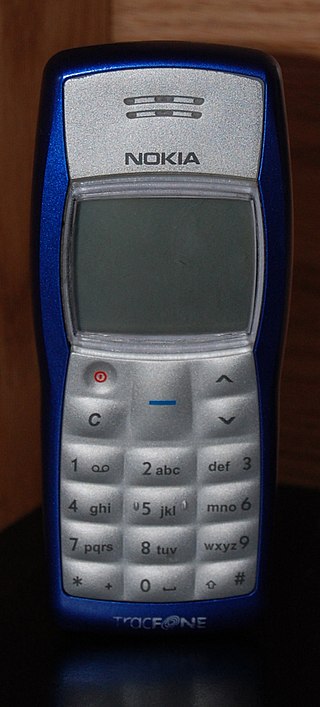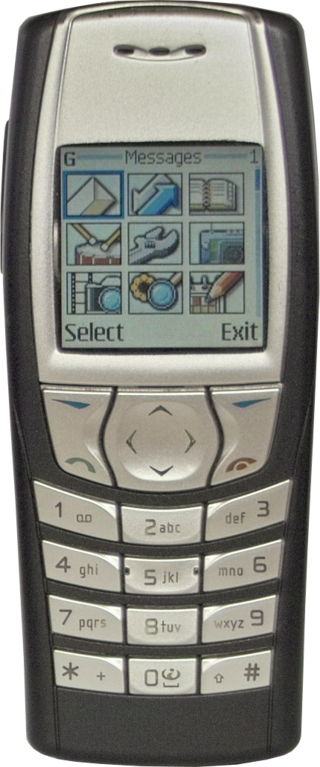
Advanced Mobile Phone System (AMPS) was an analog mobile phone system standard originally developed by Bell Labs and later modified in a cooperative effort between Bell Labs and Motorola. It was officially introduced in the Americas on October 13, 1983, and was deployed in many other countries too, including Israel in 1986, Australia in 1987, Singapore in 1988, and Pakistan in 1990. It was the primary analog mobile phone system in North America through the 1980s and into the 2000s. As of February 18, 2008, carriers in the United States were no longer required to support AMPS and companies such as AT&T and Verizon Communications have discontinued this service permanently. AMPS was discontinued in Australia in September 2000, in India by October 2004, in Israel by January 2010, and Brazil by 2010.

The Global System for Mobile Communications (GSM) is a standard developed by the European Telecommunications Standards Institute (ETSI) to describe the protocols for second-generation (2G) digital cellular networks used by mobile devices such as mobile phones and tablets. GSM is also a trade mark owned by the GSM Association. GSM may also refer to the Full Rate voice codec.
The Universal Mobile Telecommunications System (UMTS) is a third generation mobile cellular system for networks based on the GSM standard. Developed and maintained by the 3GPP, UMTS is a component of the International Telecommunication Union IMT-2000 standard set and compares with the CDMA2000 standard set for networks based on the competing cdmaOne technology. UMTS uses wideband code-division multiple access (W-CDMA) radio access technology to offer greater spectral efficiency and bandwidth to mobile network operators.
IS-54 and IS-136 are second-generation (2G) mobile phone systems, known as Digital AMPS (D-AMPS), and most often referred to as TDMA, are a further development of the North American 1G mobile system Advanced Mobile Phone System (AMPS). It was once prevalent throughout the Americas, particularly in the United States and Canada since the first commercial network was deployed in 1993. D-AMPS is considered end-of-life, and existing networks have mostly been replaced by GSM/GPRS or CDMA2000 technologies.

The Nokia 3510 is a mobile phone for the GSM network, introduced by Nokia on 12 March 2002. The phone was the first Nokia phone to bring GPRS internet services to the mass market. It was also the first Nokia phone to ship with Beatnik's miniBAE engine, allowing for playback of polyphonic ringtones.
The Nokia 3310 is a discontinued GSM mobile phone announced on 1 September 2000, and released in the fourth quarter of the year, replacing the popular Nokia 3210. It sold very well, being one of the most successful phones, with 126 million units sold worldwide, and being one of Nokia's most iconic devices. The phone is still widely acclaimed and has gained a cult status due to its reputation for durability.
GSM frequency bands or frequency ranges are the cellular frequencies designated by the ITU for the operation of GSM mobile phones and other mobile devices.

The Nokia 6110 was a GSM mobile phone from Nokia announced on 18 December 1997 and released in 1998. It is not to be confused with the newer Nokia 6110 Navigator. It was a hugely popular follower of the Nokia 2110, and the first of the many Nokia 6xxx series business-targeted phones. Main improvements over the 2110 were reduced size and improved talk time. It was the first GSM phone to use an ARM processor, as well as the first running on Nokia's Series 20 user interface.

The Nokia 1100 is a basic GSM mobile phone produced by Nokia. Over 250 million 1100s have been sold since its launch in late 2003, making it the world's best selling phone handset and the best selling consumer electronics device in the world at the time. The model was announced on 27 August 2003 and was discontinued in September 2009.
GAIT is a wireless standard developed in 1999 that allows cross-operation of mobile telephone technologies. Phones compliant with the GAIT standard can operate on either contemporary GSM networks, or the legacy IS-136 TDMA and AMPS networks found extensively throughout North America.

The Nokia 6610 is a handset by Nokia that uses the Series 40 platform and J2ME (Java). The device features text and picture messaging, a WAP browser, Stereo FM radio, Polyphonic ringtones and a 128x128, 4096-colour display. It is essentially the same phone feature-wise as the Nokia 7210, the 6610 being a more business-oriented version with a more conservatively-styled face plate and keypad layout, in contrast with the fashion-oriented 7210. It was introduced at CommunicAsia in June 2002 and was released in Q3 of the year.

A mobile phone feature is a capability, service, or application that a mobile phone offers to its users. Mobile phones are often referred to as feature phones, and offer basic telephony. Handsets with more advanced computing ability through the use of native code try to differentiate their own products by implementing additional functions to make them more attractive to consumers. This has led to great innovation in mobile phone development over the past 20 years.

Nokia 8210 is a mobile phone by Nokia, announced on 8 October 1999 in Paris. At the time, it was the smallest, lightest Nokia mobile phone on the market. A primary selling point of its design was its removable cover that allowed for easy customization. Six differently coloured Xpress-on covers are available, as well as many third-party ones.

The StarTAC is a series of mobile phones released by Motorola starting in 1996. It is the successor of the MicroTAC, a semi-clamshell design first launched in 1989. Whereas the MicroTAC's flip folded down from below the keypad, the StarTAC folded up from above the display. The StarTAC was among the first mobile phones to gain widespread consumer adoption; approximately 60 million StarTACs were sold.

The Nokia 6120 classic is a mid-range mobile phone from Nokia that was announced on 17 April 2007. It runs on Symbian v9.2 with a S60 3rd Edition FP1 user interface.

The Motorola MicroTAC is a cellular phone first manufactured as an analog version in 1989. GSM-compatible and TDMA/Dual-Mode versions were introduced in 1994. The MicroTAC introduced a new "flip" design, where the "mouthpiece" folded over the keypad, although on later production the "mouthpiece" was actually located in the base of the phone, along with the ringer. This set the standard and became the model for modern flip phones today. Its predecessor was the much larger Motorola DynaTAC and it was succeeded by the Motorola StarTAC in 1996. "TAC" was an abbreviation of "Total Area Coverage" in all three models.

The Nokia 2110 is a cellular phone made by the Finnish telecommunications firm Nokia, first announced and released in January 1994. It is the first Nokia phone with the famous Nokia tune ringtone. The phone can send and receive SMS messages; and lists ten dialed calls, ten received calls and ten missed calls. At the time of the phone's release, it was smaller than others of its price and had a bigger display, so it became very popular. It also features a "revolutionary" new user interface featuring with two dynamic softkeys, which would later lead to the development of the Navi-key on its successor, the Nokia 6110, as well as the Series 20 interface.

The Nokia 2600 classic is a Nokia Dual-band GSM phone E900/1800 or E850/1900 that includes a VGA camera, FM radio, Bluetooth, E-mail and mobile Internet access via a WAP browser. Additionally, the Nokia 2600 supports MMS and Nokia Xpress Audio Messaging, for recording and editing messages on the go. It also had a similar sliding variant called Nokia 2680 slide.
Cellular frequencies are the sets of frequency ranges within the ultra high frequency band that have been assigned for cellular-compatible mobile devices, such as mobile phones, to connect to cellular networks. Most mobile networks worldwide use portions of the radio frequency spectrum, allocated to the mobile service, for the transmission and reception of their signals. The particular bands may also be shared with other radiocommunication services, e.g. broadcasting service, and fixed service operation.
















